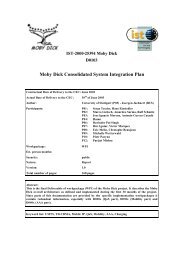j - AGH University of Science and Technology
j - AGH University of Science and Technology
j - AGH University of Science and Technology
You also want an ePaper? Increase the reach of your titles
YUMPU automatically turns print PDFs into web optimized ePapers that Google loves.
Piotr Chołda, Andrzej Jajszczyk<br />
To show how reliability measures are calculated <strong>and</strong> how to compare different<br />
recovery procedures, we chose only a few typical protection schemes. We were<br />
also paying attention to simplicity <strong>and</strong> transparency <strong>of</strong> the relevant formulas. We<br />
can note that there are also other reliability measures, e.g., the reliability<br />
polynomial for the whole network, down time ratio or average traffic loss.<br />
However, the availability is the most common measure <strong>and</strong> can be used both in<br />
very simple as well as very sophisticated (e.g., the most recent [2]) analyses.<br />
It is very important to note that many different types <strong>of</strong> availability are<br />
defined. Formally, the so called instantaneous availability is defined in terms <strong>of</strong> the<br />
ITU-T Recommendation [3] as the probability that an item is in an up state at a<br />
given instant <strong>of</strong> time. However, for our calculations we will use the concept <strong>of</strong><br />
asymptotic (steady-state) availability, which means the limit, if such exists, <strong>of</strong> the<br />
instantaneous availability when the time tends to infinity. During calculations, it is<br />
assumed that the failures <strong>of</strong> the elements are statistically-independent. The<br />
availability defined in such a way could be understood as an average ratio <strong>of</strong> time<br />
in which an item or a connection works properly, to the whole time.<br />
2. AVAILABILITY OF THE CONNECTION WITHOUT<br />
PROTECTION<br />
An unprotected connection consists only <strong>of</strong> a working path. The recovery<br />
(alternative) path is not used. The connection is interrupted when any <strong>of</strong> its<br />
elements fails. Thus, its availability equals simply an availability <strong>of</strong> a path on<br />
which this connection is established. As a path we consider a set <strong>of</strong> #L links <strong>and</strong> #N<br />
nodes through which a signal from an input node (source) to an output node (sink)<br />
is transmitted. From the reliability st<strong>and</strong>point, this is a serial structure, i.e., the<br />
structure remaining in the operation state only if all <strong>of</strong> its elements are in the up<br />
state. Therefore, the availability <strong>of</strong> a path ( A ) is determined as [4]:<br />
A<br />
=<br />
# L<br />
∏<br />
ALi N j<br />
A<br />
P<br />
×<br />
# N<br />
∏<br />
A<br />
P Li<br />
N j<br />
i=<br />
1 j=<br />
1<br />
where is the availability <strong>of</strong> link i; A is the availability <strong>of</strong> node j.<br />
3. DEDICATED PROTECTION<br />
The simplest protection scheme is called dedicated protection or 1+1<br />
protection. From the reliability point <strong>of</strong> view it is a parallel-serial structure with hot<br />
st<strong>and</strong>by, because traffic is carried both through the working <strong>and</strong> the protection<br />
paths all the time. The parallel structure means that only if all N paths fail, the<br />
connection is down. Availability for the parallel structure is calculated according to<br />
the following formula [5]:<br />
(1)

















